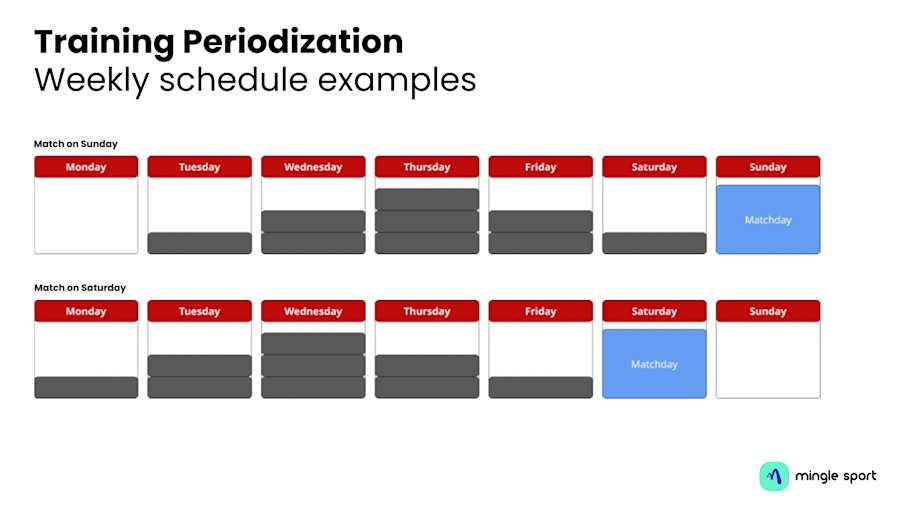Tactical Periodization in Grassroots Football: A Blueprint for Smarter Training

When coaching a grassroots football team, balancing player development, match preparation, and enjoyment can feel like a juggling act. That’s where tactical periodization comes in—a structured training approach that helps teams progress systematically while reducing the risk of burnout and injury.
What Is Tactical Periodization?
Periodization refers to planning training in structured cycles. The goal is to build fitness progressively, peak at the right moments, and keep players healthy and motivated. Tactical periodization, developed by Vitor Frade and popularized by José Mourinho and André Villas-Boas, centers everything around tactical principles. Physical, technical, and psychological elements are integrated into tactical practice—everything you do on the field should connect to your playing style.
A basic periodization model includes:
Macrocycle – The entire season (e.g., August to May)
Mesocycles – Training blocks of 4–6 weeks
Microcycles – Weekly plans within each mesocycle
Each cycle has a specific focus—whether fitness, tactics, recovery, or match prep.
Why It Matters for Grassroots Teams
Grassroots players often juggle school, work, and other commitments. They train less frequently, so every session counts. Tactical periodization helps you:
Prevent overtraining and injuries
Structure development across technique, fitness, and tactical awareness
Ensure steady progress throughout the season
Keep training purposeful, varied, and engaging
Getting Started With Tactical Periodization
🗓 Macro Level: Set Your Tactical Direction
Step 1: Define Your Tactical Principles
Before the season starts, decide how your team should play. Ask:
What formation will we use?
What is our approach during organized defending or attacking?
How do we react when we lose or win the ball?
If you're unsure, talk to your club's technical director or other coaches. Many clubs already have tactical frameworks in place.
Step 2: Set Development Goals
Identify the skills and understanding your players need to implement your tactical principles. Consider:
Technical needs (e.g., passing, pressing)
Physical demands by position
Age-appropriate developmental goals
Individual vs. team goals
📆 Meso Level: Structure the Season into Blocks
Once your macro plan is clear, break the season into 6–8 week training blocks. Base these on your team's calendar and key events like holidays or mid-season breaks.
Example Seasonal Periodization (August–April):
Pre-season (Aug–Sept)
Focus: Fitness, technique, team bondingAerobic conditioning with the ball
Reintroduce basic technical work
Small-sided games to encourage decision-making
Early Season (Oct–Nov)
Focus: Tactical structure and match fitnessBuild team shape and awareness
Introduce set plays and match tempo drills
Mid-Season (Dec–Feb)
Focus: Peak performance, load managementGame-realistic sessions
Adapt to weather and match congestion
Late Season (Mar–Apr)
Focus: Sharpening and mental toughnessIntense but shorter sessions
Refine tactics based on match data
Off-season (May–June)
Focus: Recovery and reflectionEncourage light activity and mental rest
Individual development plans
Review and plan for next season
Regardless of which periodization you decide to use, the important part is that you are creating smaller blocks each with their own focus. These focusses are based on the tactical principles and goals for your team you have decided in the first step.
🗓 Micro Level: Weekly Planning
The last step is creating your weekly schedule. Based on the smaller blocks you have created in the previous step, you are now going the focus/intensity of each of your training sessions.
An important aspect of this level is the training load during a week. Regardless of how often you train with your team, you cannot always train at 100%. This would lead to overload injuries for your players. Typically, you plan the intensity of your training sessions based on your matchday.
For example, if you play on Saturday or Sunday this is what you want the training load during the week to look like:

Following this schedule seems more logical if you train 5 times a week, but it is also still very useful for teams that train less. But it takes a bit more creativity.
Find which days you train on, and which load corresponds to these days. Let’s say you have your match day on Saturday and train on Friday and Wednesday. On Wednesday you can do a high intensity training to increase your player’s physical stamina. Friday’s can be a training in which you practice tactical principles that require less running, such as set pieces. Although you have no training on Monday, you can give your player’s the recommendation to do some active recovery at home. This can be as simple as taking a walk in the evening after dinner.
Don’t overcomplicate it and find something that fits your schedule and the goals of your team.
Tips for Implementing Periodization at Grassroots Level
✅ Involve your players – Explain the ‘why’ behind your plan to build buy-in
✅ Track progress – Simple notes on attendance, player wellness, and performance go a long way
✅ Prioritize fun – Especially for youth players, enjoyment is key to motivation and retention
Final Thoughts
Tactical periodization isn’t about rigid routines or elite-level resources. It’s about making the most of your time on the pitch. With even a simple plan, you’ll help your team develop smarter, play better, and enjoy the game more.
Start small. Stay consistent. And always coach with purpose.




